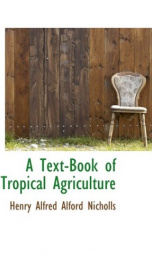a text book of tropical agriculture

Purchase of this book includes free trial access to www.million-books.com where you can read more than a million books for free. This is an OCR edition with typos. Excerpt from book: CHAPTER IV PLANT LIFE As agriculture is the art of cultivating the soil so as to pro- A knowledge ....... . . of plant life duce crops from the var1ous plants ot use to man, 1t 1s neces- necessary, sary for the agriculturist to have a knowledge of all that concerns the life of a plant. Most plants usually consist of five parts, namely, the root, the stem, the leaves, the flowers and the fruit. There are some plants, it is true, that have one or more of these parts wanting, but it is unnecessary to consider them in this work, for the tropical agriculturist is concerned mostly with the ordinary flowering plants. The ROOT, which is called the descending axis of the plant, varies very much in its character. In the grasses and other plants, the roots consist of many fibres spreading out in the soil in all directions ; some of them, indeed, are much longer than the stem, as in the case of the maizethe roots of which have been traced to the length of fourteen feet. Other roots, called tap-roots, send a thick prolongation of the main axis straight down into the soil, and give off small fibres at intervals ; the best example of this is the carrot, but Functions of coffee and cacao also possess tap-roots. Roots have two important functions : firstly, they fix the plant into the soil, or to the substance on which it grows ; and, secondly, they take up nourishment for the plant to live and thrive on. At their ends all roots become very small and tender, and give Root hairs, off minute, hair-like prolongations, called appropriately root- hairs. The extremity of a root is covered by a cap of stronger tissue so as to protect the growing point, and to enable it to make its way into the soil. The root-hairs apply themselves to the particles of the soil, and by means of the acid ...
Info about the book
Author:
Series:
Unknown
ISBN:
1177840294
Rating:
3/5 (5)Your rating:
0/5
Languge:
English
Users who have this book
Users who want this book
What readers are saying
What do you think? Write your own comment on this book!
write a commentif you like a text book of tropical agriculture try:
Other books by this author
Do you want to exchange books? It’s EASY!
Get registered and find other users who want to give their favourite books to good hands!


